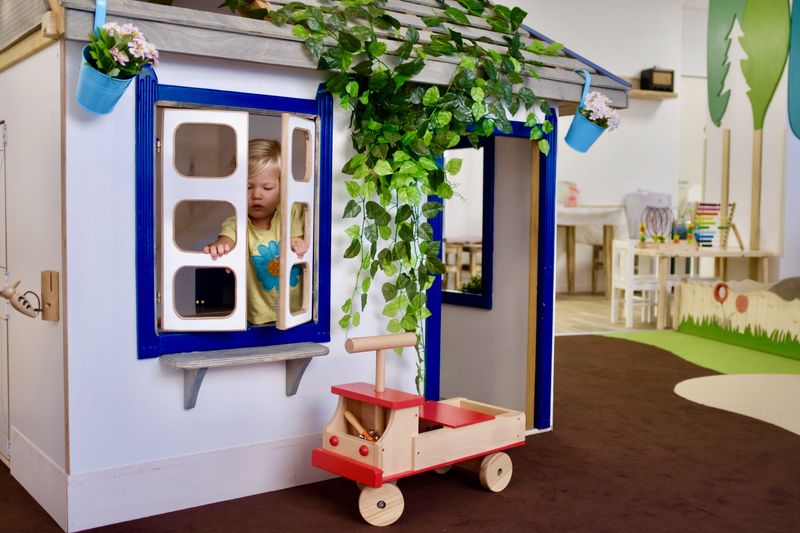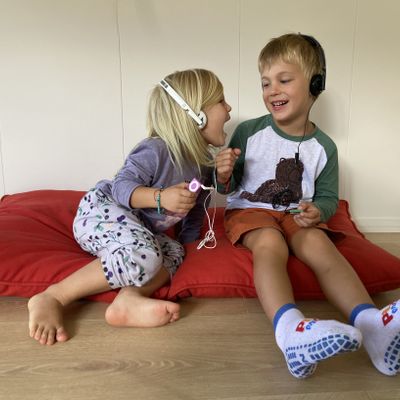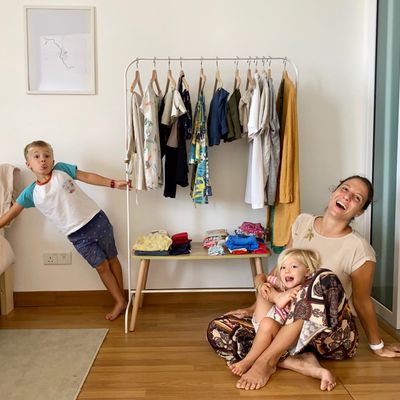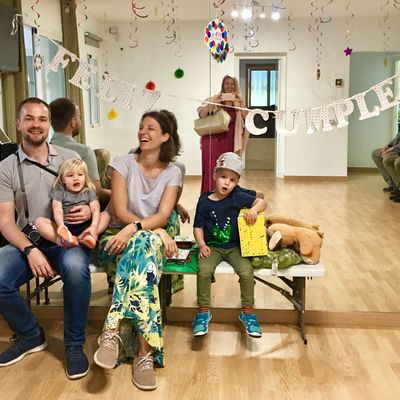Too many toys? Recycle, reduce, reuse. And educate.
I grew up with a dedicated play room for my toys. Some days there were so many toys on the floor that walking across the room was like an obstacle course. Obviously, my least favourite thing to do was to clean up the play room.
Do you know all I remember playing with? Barbies. And out of the tens of Barbies, do you how many I remember playing with? Two. Two Barbies, their horses and their house.
I don’t actually have a lesson to draw from that, I remember being very happy with my thousand toys. But as a mother—a mother and a woman deeply inspired by the Montessori philosophy and who understands the impact of stuff in our lives and what it’s doing to our planet—I made the conscious decision of having very few toys.
If right about now you’re feeling judged and guilty about how many toys your kids own, please don’t. I’m not here to criticise your lifestyle, I’m here to show you an alternative and, if you want, tell you how to achieve it.
My secret is to have few, simple rules about toys (you might have heard this a lot in my posts, I sound like a broken record):
- Own few toys
- Display some 5-6 per child on shelves, put the rest in a closet and rotate.
- Avoid baskets and boxes: they accumulate stuff you don’t need and they promote chaos and frustration.
Nice! How do you do it?
Those rules sound great, but how do you actually implement them? How can you own few toys when everybody gives your kids more toys? How can you convince your kids to get rid of extra toys?
It’s simple, and this, too, is going to sound familiar.
Recycle, reduce, reuse. And educate.
Recycle
Start a new trend of giving your kids’ toys to their friends' birthday parties. Together with your child, pick a good quality toy which is in good conditions, wrap it with recycled paper or put in a box (if you have one at home) and give it alongside a little letter:
“Dear friend, this toy belonged to me. I loved it very much, and I now would like you to have it. When you’re done with it, please pass it on to another friend for his birthday. I hope you enjoy it as much as I did”.
This is an example of how Emily and I did it for her friend Noah’s birthday party. She decided to give him her beautiful magnetic wooden rocket.


Reduce
Together with your children, make a selection of toys who they no longer (or rarely) use or they think somebody else might be happy with.
Once, Oliver decided to give away a toy that I loved simply because “my friend would love it”. He never missed it (I did!).
To make a selection, take all the toys out and together with your children, decide which are the toys that they play with the most.
Make three piles:
Keep: These are the toys they play with the most. They go on your shelves (and if there are more than 5-6, put the rest in a closet that the child has access to)
Purgatory: These are the toys they say they want to keep, but you never see them play with. They go into purgatory: a hidden place that the children can’t access nor see.
When toys stay in purgatory for longer than X time (you decide), talk to your children, remind them that they never missed them, tell them that, if they want, they can play with them one more time before you take them (together, if possible) to a charity shop or give them to friends.
By the way, purgatory also works for your clothes! Just saying ;-)
Give: These are the toys you decide (together) to give away immediately. Some children might not want to give anything away: in this case, you can explain to them: “We have played long and happily with these toys, but we haven’t used them in a long time, have we? So now, instead of been there in the closet, they could make some other kid very very happy. How about we play with them one more time, and then we take them to the charity shop?”. This has always worked for me.
Stop using boxes and baskets
Getting rid of boxes and baskets goes hand in hand with reducing the amount of toys you own. Baskets always mean more stuff. Boxes and baskets hide the mess, they don’t fix it. They don’t promote a change in mentality. They don’t promote a less consumeristic society.
But that’s not the only reason why to avoid baskets.
What does a child do when he wants to find a toy in a basket? He turns the basket over. And what happens when it’s time to tidy up? He gets frustrated, because the mess is out of control. It’s only understandable he doesn’t want to tidy up.
Having toys on display promotes order (small baskets on shelves to keep together the pieces of ONE toy are OK, like a puzzle). Kids don’t need to be taught how to be tidy: they love order, they just need the right tools and the right environment to nurture their love of order.
Reuse
For me, this means rotate and use what you already have at home.
Keep 5-6 toys on display on your shelves, and put the rest in a closet the child has access to. When your child wants to play with a toy in the closet, he has to decide which other toy to put away (you’ll be surprised how quickly he decides). Then rotate toys periodically, depending on the children’s interest.
How and when to rotate toys?
The only way to decide what toys go on your shelves, and when it’s time to rotate them is to observe your children play. Observing my children has been one of the greatest lessons I learned from Montessori, and it also applies to making a selection of toys or decide on a present for their birthday.
Sit down and just observe them play: don’t multitask, if you see yourself getting distracted, take notes! Observe what they use and what they don’t, observe how long they play with a toy or if, instead, they just take it and leave it right away.
Observe how they play with toys: do they peel the paper off their wax crayons? Maybe an activity like tearing/cutting paper stripes might get them engaged! Do they make a tower with the pieces of their sorting toy? Give them more stacking activities, even just stacking stones will do!
Interests come and go (sometimes quickly), but then they might come again, which is why rotating toys works so well: when they use a toy again after not having seen it for a while, it’s like having a new toy. No need to buy more, just reuse what you have.
Sometimes on our shelves there were only puzzles for Oliver (some of which we bought second hand), and paper cutting and gluing activities for Emily. That’s all they always did, so we removed everything else. When they weren’t engaged anymore, I knew it was time to rotate them. But I could have never known without observing my children play.
How many toys did you have in total?
You also ask this question a lot, so here it goes: we always had between 25 and 30 toys. Around 10 were on our shelves (for two kids of different ages), and I kept the rest on shelves in my closet. To be honest with you, I now think this was too much.
Oliver and Emily now have only Lego, a couple toy cars, one Curious George soft toy, one doll, one small elephant toy and about 25 thin books from the Jolly Phonics non-fiction collection, and they are happy. They don’t need more. They build houses and trains using chairs and couch pillows, they put a string on George and pretend it’s a dog… even when the AirBnb leaves some toys for them, they usually play more with their own.
Educate
This is the most important part. All of this won’t make a difference in your life if you don’t educate the people around you. If you don’t explain it to grandparents and friends, when birthdays and Christmas come. If you don’t take the time to find creative solutions for people to be happy with not giving gifts.
Here’s two great ideas:
- Only one gift at birthday parties and everybody chips in: you can read my post about the birthday gift fund envelope to understand how to do this. You find it in the suggested articles below.
- Experiences over stuff: grandparents, especially, love to give gifts. It’s their way of showing love, and I wouldn’t take that from them. If you don’t need toys (sometimes you do), I would explain to them how important it is for you to have few toys and the right ones, so I would ask them kindly to discuss with you their gift ideas, before buying.But more importantly, I would talk to them about the possibility of giving experiences to your kids instead of stuff: they can take their grandchildren to a new park, to a dinosaur exhibit, to see the snow, to spend a day on the beach or at the farm. Tell them to take pictures that they can watch with their grandkids. Kids will love and remember that more than any material gift.
I know some families who don’t buy toys during the year, so they can give family and friends a wish list for their kids’ birthday parties. I think this is a lot better than having people freely decide what gift to give, because people don’t know nor observe your kids and WILL end up giving gifts you won’t ever use: this is sad for them, for your kids and for the planet.
Personally, I always preferred buying toys when I saw a need or a recurrent interest*, instead of waiting for a special event like their birthday: I think this is also a better way to avoid birthday parties that look like weddings, and to change our mentality about consumerism. (*When I say “interest”, I mean puzzles, building, books, geography, science, rockets… Being interested in a specific friend’s toy is not an interest I’d act on: they can play with that toy when they’re at their friend’s house :-))
Because the truth is, we really do need to change our mentality about consumerism. Our society can do better. We can do better. Let’s show it.














